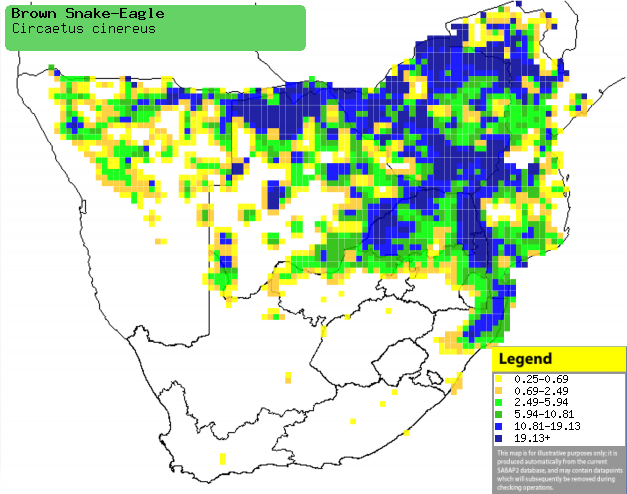|
Circaetus cinereus (Brown
snake-eagle)
Bruinslangarend [Afrikaans]; Ekangakodi (also applied to
some of the other eagles) [Kwangali]; Ghama (generic term for eagle)
[Tsonga]; Bruine slangenarend [Dutch]; Circačte brun [French]; Brauner
schlangenadler [German]; Įguia-cobreira-castanha [Portuguese]
Life
> Eukaryotes >
Opisthokonta
> Metazoa (animals) >
Bilateria >
Deuterostomia > Chordata >
Craniata > Vertebrata (vertebrates) > Gnathostomata (jawed
vertebrates) > Teleostomi (teleost fish) > Osteichthyes (bony fish) > Class:
Sarcopterygii (lobe-finned
fish) > Stegocephalia (terrestrial
vertebrates) > Tetrapoda
(four-legged vertebrates) > Reptiliomorpha > Amniota >
Reptilia (reptiles) >
Romeriida > Diapsida > Archosauromorpha > Archosauria >
Dinosauria
(dinosaurs) > Saurischia > Theropoda (bipedal predatory dinosaurs) >
Coelurosauria > Maniraptora > Aves
(birds) > Order: Falconiformes
> Family: Accipitridae
> Genus: Circaetus
Distribution and habitat
Occupies much of sub-Saharan Africa, excluding the lowland
forest of West Africa. In southern Africa, it is locally common across Mozambique, northern and
eastern South Africa, Zimbabwe, Botswana and the northern half of Namibia
(including the Caprivi Strip). It generally prefers more wooded habitats than
the Black-chested snake-eagle, such as
Mopane (Colosphermum mopane) and miombo (Brachystegia) woodland,
Kalahari thornveld and wooded granite hills in Matopo, Zimbabwe.
|
 |
|
Distribution of Brown snake-eagle in southern Africa,
based on statistical smoothing of the records from first SA Bird Atlas
Project (©
Animal Demography unit, University of
Cape Town; smoothing by Birgit Erni and Francesca Little). Colours range
from dark blue (most common) through to yellow (least common).
See here for the latest distribution
from the SABAP2. |
Movements and migrations
Little known, as it is thought to be nomadic in
some areas and resident in others. It is most common in Namibia in
summer and Zimbabwe in winter, suggesting that it might migrate from
east to west.
Food
It mainly eats snakes, doing most of its hunting from a
perch, dropping onto prey from above and smashing its spine with its
feet. If the prey is a snake, it crushes the head to discharge any venom then
swallows it whole. Its legs are thickly scaled to protect
it from snake bites, but it is not immune to venom, and is sometimes blinded by
spitting cobras. The following food items have been recorded
in its diet:
- Reptiles
- Other (both recorded in east Africa)
Breeding
- Probably a monogamous solitary nester, performing an aerial display in the
breeding season in which it dives and rises repeatedly.
- The nest is built by both sexes in roughly a month, consisting of a
platform of thin sticks with a deep cup set into it, lined with leaves. It
is typically placed in the canopy of a flat-topped tree, especially a large
Euphorbia, Knob-thorn (Acacia nigrescens), Beechwood (Faurea
saligna) or Horn-pod tree (Diplorhynchus condlyocarpon). It may
use the nest of another bird, such as the
Tawny eagle, Wahlberg's eagle,
African hawk-eagle or
African harrier-hawk.
- Egg-laying season is nearly year-round, peaking from about
October-January.
- It lays a single egg, which is usually incubated solely by the female
for 48-53 days; the male rarely assists with incubation, but
regularly provides the female with food.
- The chick is brooded almost constantly by the female for the first ten
days of its life, thereafter brooding more intermittently, ceasing
completely when the chick becomes about 35 days old. The chick
eventually leaves the nest at 95-112 days old, becoming fully independent
about a week to two months later.
Threats
Not threatened.
References
-
Hockey PAR, Dean WRJ and Ryan PG 2005. Roberts
- Birds of southern Africa, VIIth ed. The Trustees of the John Voelcker
Bird Book Fund, Cape Town.
|
